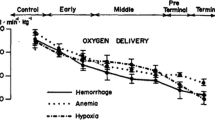Abstract
Respiratory oxygen, carbon dioxide, and nitrous oxide concentrations were recorded in 20 patients breath-by-breath during general anesthesia and early recovery, using the Cardiocap multiparameter monitor. Several approved maneuvers were performed to demonstrate the usefulness of endtidal oxygen measurement. “Oxygrams” provided by the fast paramagnetic oxygen sensor confirmed the capnometric information in the diagnosis of hypoventilation, apnea, and disconnections. In one patient, the alarm for inspiratory oxygen concentration, set at 18%, appeared to prevent alveolar hypoxia and low arterial saturation from occurring when oxygen instead of nitrous oxide was turned off. Low end-tidal oxygen levels revealed inadequate fresh gas oxygen supplementation while low flow circuits were closed. During manual hypoventilation at the end of anesthesia, the inspiratory-expiratory oxygen difference increased almost twofold while end-tidal carbon dioxide increased by only 30%. Changes in nitrous oxide concentration often complemented oxygen-related information obtained in our observations. In the recovery room, a decrease in end-tidal oxygen concentration preceded low pulse oximetry readings. Therefore, it is suggested that all three gases should be monitored continuously to prevent mishaps related to insufficient ventilation and inappropriate gas concentrations during anesthesia and immediate recovery.
Similar content being viewed by others
References
Meriläinen PT. A fast differential paramagnetic O2-sensor. int J Clin Monit Comput 1988;5:187–195
Linko K, Paloheimo M. The inspiratory — end-tidal oxygen concentration difference: a sensitive indicator of hypoventilation. Crit Care Med (in press)
Nunn JF. Applied respiratory physiology, 3rd ed. London: Butterworth, 1987
Smalhout B, Kalenda Z. An atlas of capnography. Zeist, The Netherlands: Kerkebosch, 1983
Paloheimo M, Valli M, Ahjopalo H. A guide to CO2 monitoring (manual). Helsinki, Finland: Datex/Instrumentarium, 1983
Whitcher C. Oxygen monitors in the OR. In: Proceedings of the American Society of Anesthesiologists 38th annual refresher course, lectures and clinical update program, 1987 Oct 10–14. Atlanta: American Society of Anesthesiologists, 1987:222B
Marshall BE, Wyche MQ Jr. Hypoxemia during and after anesthesia. Anesthesiology 1972;2:178–209
Read J. Pulmonary ventilation and perfusion in normal subjects and in patients with emphysema. Clin Sci 1959;18:465–473
Fairley HB. Respiratory monitoring; methods assessing oxygen delivery. In: Blitt CD, ed. Monitoring in anesthesia and critical care medicine. New York: Churchill Livingstone, 1985:244–249
Southorn PA, Mackenzie RA, Gould AB, Offord KP. Routine end-tidal carbon dioxide tension monitoring in the immediate postoperative period. Anesth Analg 1984;63:275
Block FE Jr. Clinical controversy. A carbon dioxide monitor that does not show the waveform is worthless. J Clin Monit 1988;4:213–214
Author information
Authors and Affiliations
Rights and permissions
About this article
Cite this article
Linko, K., Paloheimo, M. Monitoring of the inspired and end-tidal oxygen, carbon dioxide, and nitrous oxide concentrations: Clinical applications during anesthesia and recovery. J Clin Monitor Comput 5, 149–156 (1989). https://doi.org/10.1007/BF01627446
Received:
Revised:
Accepted:
Issue Date:
DOI: https://doi.org/10.1007/BF01627446




